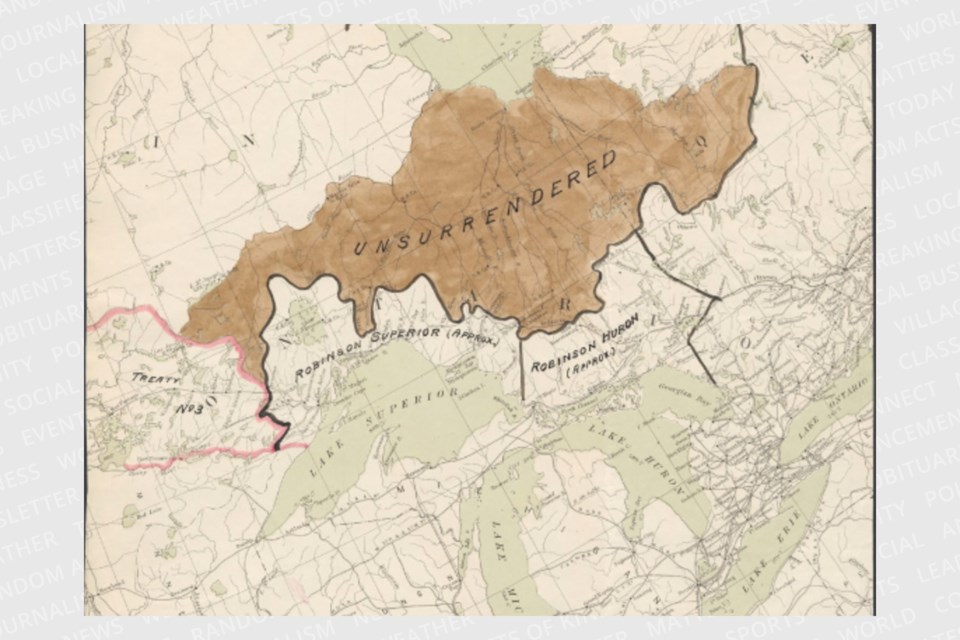The question of which Crown is obligated to pay for increases to annuities under the Robinson treaties was a hot-button issue back in 1875, the last time the annual payments to the Anishinabek of Lake Huron and Lake Superior were increased — to $4 per capita.
That same question has resurfaced more than 140 years later, as the Ontario Superior Court tries to determine whether Canada or Ontario has to come up with potentially billions of dollars in compensation after it awarded a yet-to-be-determined rise in annuities for beneficiaries of the pair of identical treaties signed in 1850, which ceded a large portion of land along Huron and Superior to the Crown.
Dr. Barbara Messamore — a history professor at the University of the Fraser Valley who is in a Sudbury courtroom this week testifying on behalf of Canada — says records and documents from the 1800s suggests that a couple government actors of the day were of the mind that while the Province of Canada was responsible for annuity arrears prior to Confederation, Ontario would be on the hook for both increases to annuity payments and related arrears from 1867 onwards.
The historian and author pointed to an 1881 report from Robert Sinclair, an accountant with the Department of Indian Affairs, which assumed that arrears stemming from the 1875 annuity increase would be the obligation of what was then known as the Province of Canada before Confederation. Ontario, under this assumption, would be responsible for both ongoing Robinson treaty annuities and related arrears.
That assumption was also echoed in correspondence from federal deputy finance minister J.M. Courtney and deputy superintendent of Indian Affairs Lawrence Vankoughnet the following year.
Upon Confederation on July 1, 1867, the Dominion of Canada proceeded to charge more than $140,000 to the Province of Ontario for annuity arrears related to the pair of Robinson treaties.
Ontario’s treasurer at the time, A.M. Ross, objected to the transfer of Robinson treaty annuities arrears. In an 1884 letter to Courtney, Ross argued that Ontario wasn’t responsible for the arrears because the Anishinabek did not make a claim for increases to annual treaty payments at the time the arrears were transferred to Ontario. He further argued there was no evidence to suggest that the lands within Huron and Superior treaty territory generated enough wealth to warrant any annuity increase.
In 1874, Ontario’s premier and attorney general Oliver Mowat also denied any liability for increases to Robinson treaty annuities. The Dominion of Canada was responsible for the increased annuities, Mowat argued, without prejudice as to which government would be held responsible for them down the road.
What's at stake in the annuities court cases for beneficiaries of the Robinson Superior Treaty (RST) and Robinson Huron Treaty (RHT) depends on what expert is taking the stand in court. While experts testifying on behalf of Ontario say Robinson Superior beneficiaries are owed around $85 million, an economist providing testimony for Whitesand and Red Rock First Nations claims the Anishinabek in both treaty territories could be owed more than $100 billion.
The legal proceedings for both court cases have been broken up into three stages due to their sheer complexity.
Ontario Superior Court Justice Patricia Hennessy ruled in the previous two stages of the trial that the federal and Ontario governments had to pay both RHT and RST plaintiffs an increased annuity due to an augmentation clause allowing for increases to treaty payments "from time to time" as wealth generated on the land grew. But the annuity increase, Hennessy ruled, has to reflect a “fair share,” so long as there were enough resource-based revenues to do so without incurring a loss.
While Canada is not appealing those previous decisions, Ontario has decided to appeal to the Supreme Court of Canada after the Ontario Court of Appeal upheld Justice Hennessy’s decision.
The hearing for Ontario’s Supreme Court appeal is slated for the fall of 2023, with a decision expected to be handed down as early as the spring of next year.
The third stage of the RST annuities trial, which is currently being heard in a makeshift courtroom at the University of Sudbury, will determine how much money is owed to treaty beneficiaries and which of the Crowns — Canada or Ontario — will be responsible for paying the increased annuities.
A separate yet related dispute involving RHT annuities was being heard simultaneously by Ontario Superior Court Justice Justice Patricia Hennessy; the RHT legal proceedings have been adjourned since January while representatives for Ontario, Canada and RHT beneficiaries engage in confidential settlement talks.
